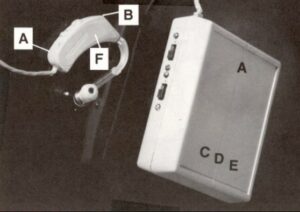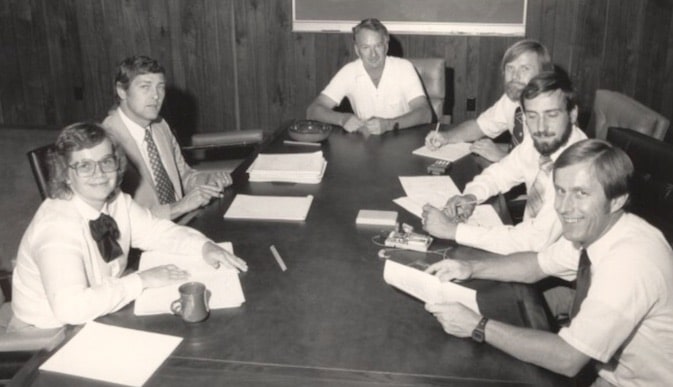Looking Back on How Digital Hearing Aids Came to Be
Today, finding an analog hearing aid is difficult – that is, unless one rummages through boxes of hearing aids manufactured prior to about 1966, or a few years following.
Hearing aid engineers had been speculating about the possibility of a digital hearing aid in the early 1980s. At that time, the development of sophisticated (by then standards) consumer electronic products (i.e., digital wristwatches, pocket computers, video games, miniature TVs, etc.) had led to similar expectations in the hearing aid field. However, it seemed that such a development presented too many problems that could not be resolved, resulting in the hearing aid being the loser in those comparisons and expected development.
The Path to Digital

Figure 1. Prototype of the first digital hearing aid ever developed as a wearable unit: (A) power supply, (B) microphones – 2, (C) A/D converter, (D) CPU, (E) D/A converter, (F) receiver.
Even though the first wearable digital hearing aid (Figure 1) was introduced in 1983{{1}}[[1]]Nunley, J., Staab. W., Steadman, J., Wechler, P., and Spencer, B. A wearable digital hearing aid, The Hearing Journal, Oct. 1983[[1]], it was not until 1996 that a commercially successful all digital hearing aid was created by Widex – a span of thirteen years. That change, from analog to digital hearing aids, was truly a disruptive technology event in the hearing aid industry.
The transition difficulties during that thirteen-year time span were related to the following:
- Few DSP (digital signal processing) chips were available/deliverable
- Limited development system capabilities
- Few people skilled in DSP implementation for low-voltage devices
- Required retraining of designers from analog to digital technology
- It was not possible to merely replace a DSP chip with an analog chip (DSP chip size was too large and power were not compatible with hearing aid 1.4 voltage requirements)
Little published data is available about this first digital wearable device. But, because of its historical significance, and in an effort to archive some of this information, this post is being written about it. A few other developments occurred around the same time, and shortly after, that utilized computer technology to develop ideas about digital signal processing in hearing rehabilitation, and they will be presented in future posts.
The photos and descriptions in this post and in following related posts will provide the reader with information that attests to the developmental requirements that were involved in producing and miniaturizing the product that is the contemporary digital hearing aid.
The Audiotone Wearable Digital Hearing Aid (1983)
At the time of its invention, the concept of digital hearing aids meant nothing, or little, to most people in the hearing aid industry – a few engineers excepted. The interest was in designing hearing aids that were smaller and having more functions. Most people selling and fitting hearing aids viewed the presented digital hearing aid as a definite step backwards – a product that was larger and that could not perform many of the functions of contemporary hearing aids. The complexities of designing for digital to replace analog circuitry were not understood or appreciated.
In April of 1981, Audiotone, in conjunction with a noted research consulting company, Integrated Circuit Engineering Corporation, conducted a study to determine the then-current state of digital development and what the future might hold. The result of the survey indicated that circuitry could be available for a body-worn hearing aid within 5 to 10 years. This resulted in a serious commitment to begin the development of DSP circuitry for hearing aids and in 1982, Audiotone entered into a joint research project with the Department of Electrical Engineering at the University of Wyoming (Figure 2), with the program under the direction of James Nunley, VP of Engineering at Audiotone.

Figure 2. Wearable digital hearing aid team. Left to right: From Audiotone R&D: Bonnie Spencer, Dr. Wayne Staab, James Nunley; and from the University of Wyoming Department of Electrical Engineering, Dr. David Egolf, Perry Wechsler, and Dr. John Steadman. Not shown, Bob Brechbiel of Audiotone engineering. The prototype product is on the table between Wechsler and Steadman.
Up to that time, very high-speed microprocessors that would allow audio-bandwidth digital filtering in real time had not been available. In fact, most currently available microprocessors at that time that were fast enough for this task required so many other devices (e.g., memory, I/O, A/D, D/A, and so forth) that the complete system was too large and required too much current for a body-worn aid – plugging into the wall was the general rule. Even though software algorithms of digital signal had been available for 20 years or more, the processing of data took hours, or even days. Such processing required the use of recorded signals, thus prohibiting the real-time processing required for a wearable instrument.
In February of 1983, the first prototype breadboard digital hearing aid was demonstrated, ahead of schedule (shown in Figure 1).
Part 2, to be published next week, takes a closer look at the contents of the Audiotone wearable hearing aid.







To be exact: Oticon presented its first fully digital instrument, the DigiFocus, one week ahead of Widex! In the perspective of human history, one week is, however, hardly significant…
Stig: Thank you for that information. Perhaps only a week, but I tend to think that is important. I will revise my time line. I do see what I wrote in other places, but I would prefer that we not try to revise history.